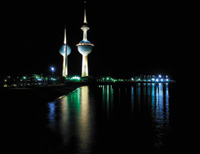
KUWAIT plans to attract family visitors as its strategy for tourism growth with the country having experienced little effect from the economic downturn. A spokeswoman for Kuwait’s tourism sector said: “Tourism in Kuwait was slightly affected by the economic recession but it was insignificant given that Kuwait depends on visitors coming from the Gulf countries, basically family tourism, which is the sort of tourism we are looking forward to in the short term.”
Kuwaitis are amongst the most enthusiastic tourists in the Middle East region. However, the domestic sector has not benefited from Kuwaitis’ great interest in travel and tourism. Industry observers attribute this to the lack of infrastructure and the small level of government efforts to promote the country as a tourist destination. The vast majorities of leisure visitors to Kuwait are from nearby countries or are family and friends visiting resident Kuwaitis and expatriates. According to the World Travel and Tourism Council, the contribution of Kuwait’s travel and tourism sector to the country’s GDP in 2009 was only 4.4 per cent and it is expected to decline to four per cent by 2020.
However, business travel has always been the most successful aspect of Kuwait’s travel and tourism industry. Indeed, 73 per cent of arrivals to the country are business travellers. In 2005 the government launched a 20-year tourism plan in an attempt to diversify the country’s economy with a key focus on expanding and enhancing business tourism.
Rising disposable income levels and the lack of tourist attractions in the country are expected to combine to create a strong base for growth in consumer expenditure on travel and tourism over the forecast period. Indeed, between 2010 and 2020 consumer expenditure on leisure and recreation is projected to grow at a CAGR of nearly five per cent, reaching KD592 million ($2.1 billion) in 2020. Consumer expenditure on package holidays is projected to grow by 25.6 per cent over the forecast period, reaching KD52.7 million ($187 million) in 2020.
However, in an attempt to generate more visitors to the country, the government recently approved the development of the Madinat-Al-Hareer (or City of Silk) in Subbiya across the Bay of Kuwait opposite Kuwait City. The 250-sq-km development is expected to have numerous tourist attractions, hotels, spas and public gardens attracting both Kuwaitis and foreign tourists alike. The new development was inspired by the ancient Silk Route and, in turn, it is aiming to revive the old trade route by creating a major free zone city linking Central Asia with Europe. There are four planned centres, including a commercial zone, a leisure and recreation zone, an ecology centre and an education and diplomacy centre.
Excerpts from Euromonitor International ‘Consumer Lifestyles, Kuwait’ report
